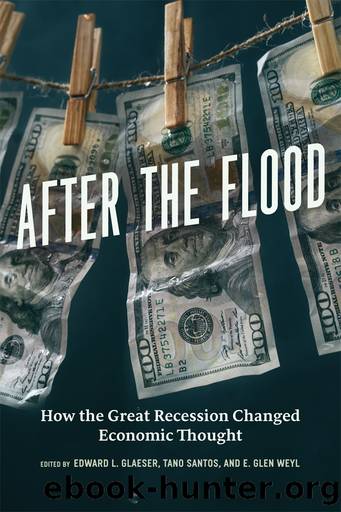After the Flood: How the Great Recession Changed Economic Thought by Edward L. Glaeser

Author:Edward L. Glaeser [Glaeser, Edward L.]
Language: eng
Format: epub
Publisher: University of Chicago Press
Published: 2017-06-15T00:00:00+00:00
a Monetary Financial Institutions
b Other Monetary Financial Institutions
Unfortunately, the crisis caught the Bank of Spain with limited supervisory and restructuring tools. When the crisis started, Spain did not have either a deposit insurance mechanism or a formal receivership procedure. The Spanish authorities thus had to improvise to create the tools needed to handle an unprecedented systemic crisis, something that would be repeated in the most recent crisis. In 1977, The Spanish FDIC (called the Fondo de GarantÃa de Depósitos en Establecimientos Bancarios, or FGDEB) was created.20 It was originally just a deposit insurance corporation without any resolution authority. This proved insufficient, given the magnitude of the crisis, and in 1980 the FGDEB was given resolution powers. It was only then that the slow process of resolving of the Spanish banking crisis can be said to have begun.21 Simultaneously a similar deposit guarantee and resolution authority institution was created for the cajas, though they were largely free from the problems plaguing the Spanish banks.
This crisis, as banking crises always do, produced a more concentrated banking system. By 1986, shortly after Spainâs entry in the European institutions and once the worst of the banking crisis was over, the Spanish credit market was dominated by seven large banks (Banesto, Central, Popular, Hispano, Santander, Bilbao, and Vizcaya) and the cajas, which were not then what they were to become. There was also a string of state-owned banks, of which the largest was Banco Exterior. Finally, and under the encouragement of the Bank of Spain, there was a small presence of foreign banks.
Entry in the European institutions, which took place in 1986, gave a renewed impetus to the liberalization of the Spanish economy.22 The Second Banking Coordination Directive in 1988 established the creation of a Single Market for Financial Services on January 1, 1993. Spanish bankers, as well as authorities, were wary that the single market would produce the takeover of the main banks by foreign entities, so a second merger wave ensued. Banco de Bilbao and Banco de Vizcaya merged first, in 1988, to form BBV. The âAâ of BBVA came afterward, when BBV merged with Argentaria, which was the entity created in 1991 to consolidate the state-owned banks.23 Banco Central and Banco Hispanoamericano merged in 1991 to create the largest credit entity at the time, BCH. The recession that started in 1992 brought yet another virulent banking crisis, in this case affecting Banesto, which at the time was one of the largest banks in Spain. Banesto was put into receivership by the Bank of Spain in 1993 and sold to Santander in 1994. This sale is at the origin of Santaderâs growth, which continued in 1999 when it merged with BCH. The resulting entity was called Banco Santander Central Hispano (BSCH) until 2007, when the name was changed to Banco Santander.
Santander and BBVA continued their growth through a strategy of international expansion. BSCH went on to acquire Abbey National in 2004, and in 2007 a joint takeover of ABN AMRO landed Santander the Brazilian subsidiary of the Dutch bank, Banco Real, which was Santanderâs ultimate objective.
Download
This site does not store any files on its server. We only index and link to content provided by other sites. Please contact the content providers to delete copyright contents if any and email us, we'll remove relevant links or contents immediately.
International Integration of the Brazilian Economy by Elias C. Grivoyannis(91531)
The Radium Girls by Kate Moore(11927)
Turbulence by E. J. Noyes(7941)
Nudge - Improving Decisions about Health, Wealth, and Happiness by Thaler Sunstein(7622)
The Black Swan by Nassim Nicholas Taleb(7016)
Rich Dad Poor Dad by Robert T. Kiyosaki(6413)
Pioneering Portfolio Management by David F. Swensen(6229)
Man-made Catastrophes and Risk Information Concealment by Dmitry Chernov & Didier Sornette(5924)
Zero to One by Peter Thiel(5690)
Secrecy World by Jake Bernstein(4651)
Millionaire: The Philanderer, Gambler, and Duelist Who Invented Modern Finance by Janet Gleeson(4382)
The Age of Surveillance Capitalism by Shoshana Zuboff(4214)
Skin in the Game by Nassim Nicholas Taleb(4165)
Bullshit Jobs by David Graeber(4100)
The Money Culture by Michael Lewis(4082)
Skin in the Game: Hidden Asymmetries in Daily Life by Nassim Nicholas Taleb(3935)
The Dhandho Investor by Mohnish Pabrai(3705)
The Wisdom of Finance by Mihir Desai(3658)
Blockchain Basics by Daniel Drescher(3511)
